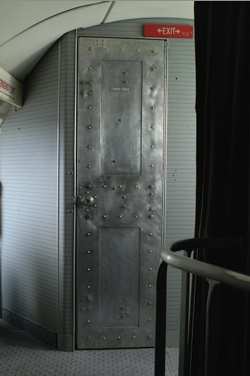 The FAA
announced that more than 10,000 aircraft serving the United States
are now equipped with new, hardened cockpit doors, making air
travel safer for [cockpit crews].
The FAA
announced that more than 10,000 aircraft serving the United States
are now equipped with new, hardened cockpit doors, making air
travel safer for [cockpit crews].
FAA Administrator Marion C. Blakey said that the airlines met
Wednesday's deadline to install doors that stop intruders and
small-arms fire because of the extraordinary cooperation between
the FAA and the door and airplane manufacturers. The FAA issued
more than 30 design approvals for 25 airplane models, many within
hours after receiving the final documentation from the
manufacturer.
"These hardened doors are part of Secretary of Transportation
Norman Y. Mineta's 'system of systems,' layers of dramatically
increased security measures from curbside to the cockpit that make
our aviation system safer than ever," said Blakey. "There was a
unified sense of urgency and cooperation between industry and
government worldwide."
U.S. Air Carriers
The Aviation and Transportation Security Act (ATSA) of 2001
directed the FAA to improve airplane security both immediately
(Phase I) and in the long-term (Phase II). On October 9, 2001, the
FAA published the first of a series of Special Federal Aviation
Regulations (SFARs) to expedite the modification of cockpit doors
in the U.S. fleet. This Phase I fix included installation of steel
bars and locking devices. The FAA determined that the security risk
outweighed potential safety risks associated with the Phase I fix
and granted short-term relief from certain airworthiness
requirements, such as how the door performs during an unlikely
rapid decompression.
On January 15, 2002, the FAA published new standards to protect
cockpits from intrusion and small-arms fire or fragmentation
devices, such as grenades. The rule required U.S. operators of
approximately 5,800 airplanes to install hardened doors by
Wednesday. It also required that the doors remain locked and
cockpit access controlled. These new Phase II doors meet all FAA
design
standards.
Foreign Air Carriers
 On June 21, 2002, the FAA published another final
rule requiring foreign airlines to install new cockpit doors on
aircraft serving the United States by Wednesday. The rule also
requires that the cockpit door be closed and locked. The FAA worked
closely with foreign aviation authorities and fully expects foreign
airlines to meet the deadline. FAA inspectors conduct random ramp
inspections of foreign airlines and may restrict flights if the FAA
determines non-compliance on the part of a foreign airline. There
are approximately 508 foreign (Part 129) airlines operating
approximately 4,213 airplanes that are authorized to operate to the
United States.
On June 21, 2002, the FAA published another final
rule requiring foreign airlines to install new cockpit doors on
aircraft serving the United States by Wednesday. The rule also
requires that the cockpit door be closed and locked. The FAA worked
closely with foreign aviation authorities and fully expects foreign
airlines to meet the deadline. FAA inspectors conduct random ramp
inspections of foreign airlines and may restrict flights if the FAA
determines non-compliance on the part of a foreign airline. There
are approximately 508 foreign (Part 129) airlines operating
approximately 4,213 airplanes that are authorized to operate to the
United States.
Costs mandated, only partially covered
The purchase of each cockpit door typically costs the airlines
between $30,000 and $50,000. The cost varied for each airline
depending on the number of aircraft being retrofitted for each
model type. Congress originally appropriated $100 million to the
FAA to distribute to U.S. airlines for aircraft security
enhancements, $97 million of which were given to the airlines to
help defray the costs of cockpit doors (approximately $13,000 per
door).
 ANN's Daily Aero-Term (05.02.24): Touchdown Zone Lighting
ANN's Daily Aero-Term (05.02.24): Touchdown Zone Lighting Aero-News: Quote of the Day (05.02.24)
Aero-News: Quote of the Day (05.02.24) Aero-News: Quote of the Day (05.03.24)
Aero-News: Quote of the Day (05.03.24) ANN's Daily Aero-Term (05.03.24): UAS Traffic Management (UTM)
ANN's Daily Aero-Term (05.03.24): UAS Traffic Management (UTM) ANN's Daily Aero-Linx (05.03.24)
ANN's Daily Aero-Linx (05.03.24)




